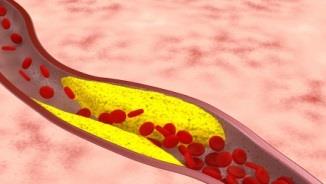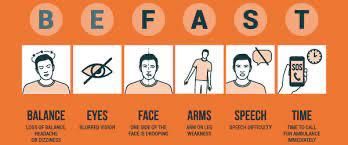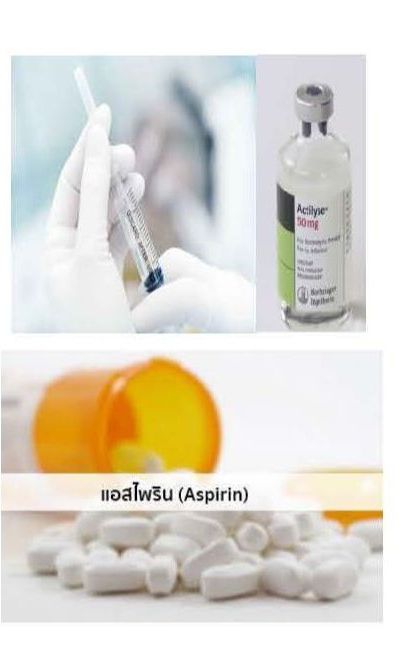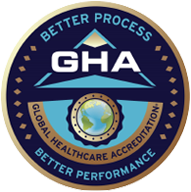Stroke
Stroke
A stroke, sometimes called brain attack, occurs when parts of the brain tissue become damaged or die caused by brain blood vessel blockages or bursts leading to reduction of blood flow and oxygen to the brain resulting functional deficits in the affected area of the brain. Stroke commonly occurs in male and age over 45 years.
In general, there are two types of stroke: ischemic stroke and hemorrhagic stroke with 80% and 20% respectively
Cause of ischemic stroke

1. Atheroscherosis occurs when there is a buildup plaque on the arterial walls causing narrowing or hardening of the arteries. The plaque consist of fats, cholesterol, calcium and other substances. Risk factors include aging, hypertension, diabetes mellitus, dyslipidemia and tobacco smoking.
2. Cardioembolism occurs when the heart pumps unwanted materials such as blood clots into the blood stream leading to the blockage of the brain arteries. Certain heart diseases can cause the cardioembolism; for instances, valvular heart disease (damaged or diseased heart valves), cardiac arrhythmia (irregular heartbeat) or myocarditis (an inflammation of the heart muscles).
3. Other less frequent causes such as cerebral vasculitis (an inflammation of the brain arteries), certain blood disorders, etc.
Cause of hemorrhagic stroke
The most important cause of hemorrhagic stroke is hypertension in particular uncontrolled hypertension. Some patients with hemorrhagic stroke might have been caused by an abnormal brain vessel from birth.
Symptoms of stroke
“BEFAST” is an acronym of signs and symptoms of stroke that occurs suddenly or acutely
B : Balance — loss of balance
E : Eyes —loss of vision, blurred vision, double vision
F : Face — face drooping
A : Arm — arm weakness or numbness
S : Speech — slurred speech, difficulty getting the words out right, confused speech
T : Time — Time to call for ambulance immediately

Risk factor of stroke
Preventable risk factor
1. Hypertension
2. Diabetes mellitus
3. Heart disease
4. Dyslipidemia
5. Obesity
6. Tobacco use
Non preventable risk factor
1. Age
2. Ethnicity
3. Gender
4. Genetic risk
Prevention of stroke
1. Regular physical activity
2. Keep healthy weight
3. Do not smoke
4. Annual physical check up to screen for preventable risk factors
5. Control medical conditions
6. Take medicines to control the risks to prevent stroke occurrences or recurrences
Diagnosis of stroke

Coupled with patient history and examination, brain imaging such MRI or CT scan remains the gold standard when it comes to diagnosis of stroke. Some patients may need additional tests, e.g. echocardiogram (an ultrasound of the heart), carotid ultrasonography (an ultrasound of great artery of the neck), etc to look for the cause of stroke.
Treatment of stroke

In general, there are three measures of stroke treatment: medication, surgery and rehabilitation.
1. Medication:
In acute period of ischemic stroke within 4.5 hours after the onset, the patient will be determined whether they are eligible for thrombolytics (clot-busting drugs) or not. After the acute period, antiplatelet drugs will be given for prevention of further blood clot formation.
2. Surgical decompression:
When the stroke involves large area of the brain causing marked brain swelling that potentially harms the brain by compressing the adjacent vital parts or increasing pressure in the skull.
3. Physiotherapy:
The aim of the physiotherapy is to help with muscle weakness as they are trained to maximize and improve function to or close to its normal level before the stroke in order to prevent disability and improve the quality of life.
The physiotherapy for patient with muscle weakness on one side of the body (hemiparesis) includes but not limited to:
1. Muscle strength training
2. Transferal technique
3. Lying positioning correction

Transcranial magnetic stimulation (TMS)
TMS is a noninvasive (done without using surgery or cutting the skin) procedure that uses magnetic fields to stimulate nerve cells in the brain through an electromagnetic coil
TMS can be used in patient with stroke to improve neurological symptoms such as muscle weakness, speech and language difficulty.
Medication advice
The most essential drugs for patients with stroke are:
1. Antiplatelet medications
1.1) Aspirin is the most commonly used antiplatelet medicine when the stroke has just happened.
Side effects include bleeding complications such as skin bruises and stomach or gut bleeding, upset stomach or vomiting. If these symptoms occur, immediate report to the treating physician is suggested.
- Due to its stomach irritating effect, it is best taken with or just after food, not on an empty stomach
- Avoiding to taking with alcohol to help prevent stomach irritation.
1.2) Clopidogrel
- Side effects include rash, chest discomfort, headache, blurred vision, upset stomach. Take with cautions in patient with liver disease or bleeding disorder.
1.3) Cilostazol
- Side effects include headache, rapid heartbeat and palpitation.
2. Anticoagulant (blood thinner) medications is used to reduce clot formation which can cause a stroke
2.1) Warfarin
- Exactly take warfarin as directed. Do not self adjust the dose or stop taking the medicine without consultation with the treating physician.
- Blood tests (called INR) are needed to be done to make sure the dose is right to prevent the clot
- Side effects include bleeding such as red urine, bruises, gum bleeding, bloody vomiting, dark stool, etc. If signs of bleeding occur, immediately report the doctor and temporarily withhold the drug.
- When a surgical procedure is planned, inform the doctor that the drug is currently taken. In addition, report to the pharmacist when buy any drugs at a drugstore.
Dietary advice
Eat healthy diet to keep the blood lipid and sugar levels as well as the blood pressure in normal range to reduce the recurrent risk of stroke.
1. To reduce cholesterol level
1.1) Avoid eating fatty meat such as bacon, chicken skin, fatty beef, oxtail meat, etc. Eat only lean meat, skinless meat, headless prawns, crab (egg removed). Eat more fish and no more than one egg yolk per day.
1.2) Eat no more than one coconut curry or coconut milk dessert per week. Do not add a large amount of coconut milk in foods.
1.3) Eat fried food items no more than 1-2 times a week. More boiled, steamed, roasted, baked and less-oil or oil-free recipes.
1.4) Choose proper oils for cooking
2. To control blood pressure
2.1) Reduce salty foods by reducing monosodium glutamate (flavor enhancer) or seasoning powder. Salt should be limited to no more than 1 teaspoon per day or else fish sauce or soya sauce of no more than 3-4 teaspoons per day. To enhance the flavor, pepper or sour taste ingredient can be added). If do not cook by yourself, avoid buying soups, curries and fried vegetables.
2.2) Avoid eating preserved and processed foods specifically instant noodles, canned fish, pickled cabbage and salted fish. If unavoidable, eat less or no sauces, pickling liquid and seasoning powder.
2.3) Increase high-fiber diets such as vegetables, fruits and unpolished rice in order to decrease fat absorption and maintain the feeling of fullness for a longer time. Also, they are rich of minerals that help control blood pressure.
2.4) Eat fruits, cereals, roasted unflavored nuts or unsweetened Thai desserts in stead of salty snacks, bakeries or coconut milk desserts.
Smoking tobacco cessation advice
Tobacco use is a strong causative risk factor of stroke by hardening the brain arteries leading to blocking or decreasing the blood flow that carries oxygen and nutrients to the brain. Smoking tobacco cessation is therefore essential in stroke prevention as well as hypertension and a heart attack.

Mental health advice
Patients with stroke are at higher risk of depression as a result of an imbalance of brain chemicals from stroke. Moreover, the patients may suffer from stress due to the physical disability. Caregivers and family members can help empower and complement them to live their lives with joys and hopes. If depression is suspected, urgently inform the treating physician to seek for the appropriate treatment.tiplateletsThrombolytics
Palm oil, coconut oil, pig oil and cheese for deep frying(less consumption)soybean









